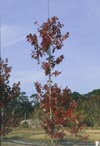Home > Tree selection > Uncommon trees zone 8-9 > Acer rubrum
Acer rubrum 'Florida Flame',
Florida Flame Maple
'Florida Flame' is a more consistent grower (compared to the variable red maple species) with bright red emerging foliage and good fall color, even in Florida. This offers advantages for the grower and landscape architect when using red maple in Florida. Young twigs are brittle and may result in some twig drop following storms.
The tree makes the best growth in wet places in the southern portion of its range but adapts nicely to drier locations in the northern and central portion of its range where rainfall is greater than 40 inches. In fact, it can grow into hardiness zone 10 provided it is planted on a wet site. Trees in the northern portion of its range can grow to more than 100 feet tall in their native habitat.
Red Maple may develop chlorosis on alkaline soil (pH >7.2) due to manganese deficiency where it also grows poorly. Red maple is taking over (invading) many woodlands throughout its hardiness range due to fire suppression designed to protect urban structures. Trees sprout readily from cut stumps. This is the state tree of Rhode Island.
It is well-suited as a street tree in northern and mid-south climates in residential and other suburban areas but the bark is thin and easily damaged by mowers. Irrigation is often needed to support street tree plantings in well-drained soil in the south. Be sure to plant a Red Maple grown from a seed source as close to the planting site as possible, preferable within a hundred miles. Northern seed sources perform poorly in the south; southern seed sources perform poorly in the north. Trees in one study in NY had trouble recovering from bare-root transplanting.
Red maples are slowly taking over some moist, eastern deciduous forests. Before 1900, Acer rubrum remained mainly in swampy areas but recently has taken over some upland sites. Experts believe the major cause is the repression of forest fires, which killed maples and spared thick-barked species such as oaks, hemlocks and hickories. Acid rain, which red maples tolerate, is another potential cause.
Red
Maple tends to form included bark in the crotches of main branches that
makes the tree susceptible to breakage. Soft wood results in mid-limb
failure in ice storms. Storms also break out sprouts from previous topping
cuts. Trees transplant easily but are not very resistant to decay when
injured or pruned improperly. Silver Maples are considered better compartmentalizers
of decay than Red Maple, but red maple is a fairly good compartmentalizer.
Roots can raise sidewalks as silver maples can but they have a less aggressive root system and so they make a good street tree. Surface roots beneath the canopy can make mowing difficult. Roots growing into mulch resting on the side of the trunk can girdle the trunk. Branches sometimes grow upright through the crown forming poor attachments to the trunk. These should be cut back (or removed if they are small in diameter) in the nursery or after planting in the landscape to help prevent branch failure in older trees during storms. Soft wood results in mid-limb failure in ice storms. Storms also break out sprouts from previous topping cuts.
Wood specific gravity averages about 0.54 g/cc. The wood is considered diffuse porous which means that there is little difference in size between the spring wood pores and the summer wood pores. Plants serve as hosts for the tiger swallowtail (Papilio glaucus) butterfly larvae.
Abundant
and widespread in eastern North America due to its tolerance to different
soil types, pH, moisture, elevation and soil texture. Grows from sea level
to 3000 feet elevation as a subclimax species in bogs to mountain tops.
In Florida and at the extremes of its southern range, it is almost exclusively
a swamp plant.


